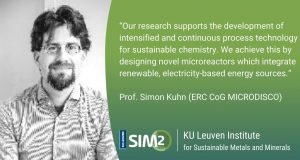— Fabio Grimaldi, UCL
The chemical process industry—and in particular the fine chemicals and pharmaceuticals industries—is experiencing a transition from batch to continuous production.
Currently, the conventional technologies in these sectors tend to be batch type, combined with mechanical mixing and conduction-based heat transfer, inherently leading to poor process control.
As part of the Marie Skłodowska-Curie Horizon 2020 European program, the COSMIC project, Continuous Sonication and Microwave Reactors, deals with this transition. The aim is that of intensified processes where continuous technologies use alternative energy sources to achieve the localized ultrasound and microwave actuation of multiphase and micro-flow reactors for the purpose of high-value product synthesis—notably with focus on the synthesis of organic molecules and nanoparticles for use in organic syntheses, catalyst preparation and health applications. All of which are important domains in the fine chemicals and pharmaceuticals industries today and into the future.
How to evaluate and assess this transition?
Life Cycle Assessment (LCA) is an effective and powerful tool to assess overall environmental burdens of a product or a service. LCA takes in consideration the whole life cycle of a system, i.e., from cradle to grave, rather than focusing on only a specific stage (usually the production stage), which has been the typical approach for many years.

From Cradle to Grave (Project HUB 360)[1]
The use of the LCA methodology has spread considerably all over the world during the last decade becoming a mandatory requirement for existing or newly-designed products or services, and for this purpose it has been standardised by the International Standard Organization. In Europe, robust and firm directives have been recently given about sustainable development with the Circular Economy package.
In this respect, the LCA may serve as a supportive tool to decision-making processes within the transition from batch to continuous micro-flow by giving a holistic view of the environmental impact of the whole process.
The application of the LCA methodology to microfluidics and nanoparticles presents many challenges: to date, few LCA studies within the manufacturing process of Engineered Nanoparticles (ENPs) have been carried out, and a standardised methodology to evaluate their environmental impact has not yet been developed. Therefore, the goal of the present study is the development and application of a standardised LCA framework in order to assess, compare and give guidelines in the transition from batch to continuous in ENPs manufacturing.
[1] The Project HUB 360 – Scientific & Applied Solutions <http://www.project-sas.com/life-cycle-assessment—lca.html>




